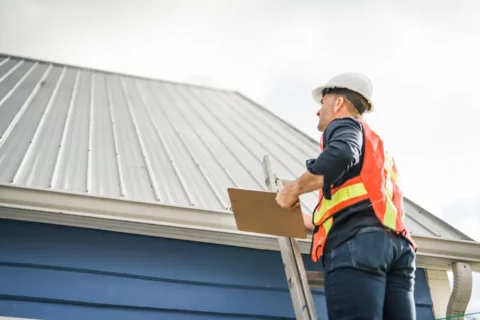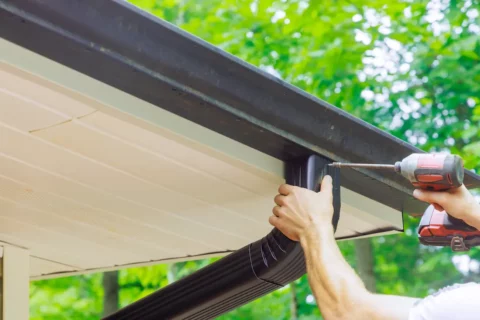Welcome to the 303 Roofer blog, your ultimate source for all things roofing in Denver, Colorado! We understand that homeowners in the Mile High City face unique challenges when it comes to their roofs, especially with the frequent hailstorms that can wreak havoc on rooftops. If you’re a Denver resident who has experienced the wrath of hail and is now wondering how to navigate the insurance claim process for your roof hail damage, you’ve come to the right place.
At 303 Roofer, we take pride in being the go-to roofing experts in Denver. Our mission is to empower homeowners like you with the knowledge and guidance needed to protect your most valuable asset – your home. Hail damage to roofs is a serious issue, and understanding the ins and outs of insurance claims is essential to ensure that your roof repairs are covered and carried out efficiently.
Don’t let hail damage compromise the integrity of your home or drain your finances. By learning the ropes of insurance claims and having a reliable roofing partner like 303 Roofer by your side, you can take charge of the situation and get your roof back to its best condition.
Understanding Roof Hail Damage and Its Impact on Your Roof
Before delving into the insurance claim process, it’s crucial to understand what hail damage is and how it can affect your roof. Hailstones vary in size and can be as small as a pea or as large as a golf ball, causing significant damage upon impact. As these icy pellets pummel your roof during a hailstorm, they can leave behind visible signs of damage that, if left untreated, may lead to more severe issues over time.
Common signs of roof hail damage include:
- Dents or depressions on shingles: Hail can create small or large dents on asphalt shingles, weakening their protective layer.
- Cracks or splits: Hail impact may cause shingles to crack or split, compromising their ability to shield your home from the elements.
- Granule loss: As hailstones strike the roof, they can dislodge granules from shingles, leaving bare spots that expose the underlying material to potential damage.
- Soft spots or bruising: Underneath the shingle’s surface, hail can bruise or create soft spots, leading to potential leaks and water infiltration.
Assessing Your Roof’s Hail Damage
Following a hailstorm, it’s essential to assess the extent of damage your roof has sustained promptly. While you can perform a preliminary inspection from the ground, it’s best to enlist the help of professional roofing contractors, like 303 Roofer, for a thorough examination. Our experienced team knows what to look for and can identify even subtle signs of hail damage that may go unnoticed to the untrained eye.
Here’s what you can do to assess your roof’s hail damage:
- Preliminary Inspection: Begin by examining your roof from the ground with binoculars, looking for visible signs of damage such as missing or dented shingles. Also, check for any debris that might have accumulated in your gutters or downspouts.
- Documenting the Damage: Take clear photographs of any observed hail damage. Make sure to capture different angles and areas of your roof to provide comprehensive documentation for your insurance claim.
- Professional Inspection: Reach out to 303 Roofer to schedule a professional roof inspection. Our experts will climb onto your roof, conduct a detailed assessment, and provide a comprehensive report of the damage.
- Insurance Claim Preparation: Use the information gathered from your preliminary inspection and the report from our roofing experts to prepare for your insurance claim. Having documented evidence of the damage will support your claim’s validity and expedite the process.
Navigating insurance claims can be overwhelming, but don’t worry; we’ve got your back. We will guide you through the process of filing an insurance claim for your roof hail damage, ensuring you have the best chance of getting the coverage you deserve.
Filing an Insurance Claim for Roof Hail Damage
Filing an insurance claim for roof hail damage requires careful attention to detail and a thorough understanding of your homeowner’s insurance policy. Here’s a step-by-step guide to help you through the process:
- Contact Your Insurance Company
Report the hail damage to your insurance company as soon as possible. Provide them with a brief description of the damage and request the necessary claim forms. - Document Everything
Share the photographs and documentation of the hail damage you collected during the assessment with the insurance company. This evidence will support your claim and help the adjuster assess the extent of the damage accurately. - Get an Estimate
Request a detailed repair estimate from 303 Roofer or another reputable roofing contractor. Including an estimate from a professional roofer will give your claim more credibility and ensure that all necessary repairs are considered in the assessment. - Be Prepared for an Adjuster’s Visit
The insurance company will likely send an adjuster to inspect the damage in person. Accompany the adjuster during the inspection and point out all visible signs of hail damage you’ve noticed. Also, share the professional roofing report and estimate. - Review Your Policy
Familiarize yourself with the coverage and limitations of your homeowner’s insurance policy. Understanding what is covered and what isn’t will help you manage your expectations during the claims process. - Communicate Clearly
Be responsive and provide any additional information the insurance company requests promptly. Open communication will keep the process moving smoothly.
Understanding Insurance Coverage and Policy Limits
Insurance policies can vary in coverage for roof hail damage, depending on the type of policy you have and its specific terms. Here are some key points to understand:
- Covered Perils
Check your policy to see if it includes “perils” such as hailstorms. If hail damage is a covered peril, your insurance should provide coverage for repairs. - Deductible
The deductible is the amount you must pay out of pocket before your insurance coverage kicks in. Review your policy to know your deductible amount. - Coverage Limitations
Policies may have coverage limits, which means they will only pay up to a certain amount for repairs. Ensure you are aware of these limitations. - Actual Cash Value vs. Replacement Cost
Understand whether your policy provides actual cash value or replacement cost coverage. Actual cash value considers depreciation, while replacement cost coverage pays for the full cost of repairs or replacement without factoring in depreciation. - Roof Age
Some insurance policies may consider the age of your roof when determining coverage. If your roof is older, coverage for repairs may be reduced.
Remember, every insurance policy is unique, and it’s essential to review yours carefully or consult with your insurance agent to understand the specifics of your coverage.
Navigating insurance claims can be complex, but with the right information and professional support from 303 Roofer, you can successfully get your Denver roof hail damage covered.
The Insurance Claim Process and Timeline
Understanding the insurance claim process and its timeline can help you prepare for what lies ahead. While each claim is unique, the general process often follows these steps:
- Filing the Claim: After reporting the hail damage to your insurance company and providing all necessary documentation, you officially file the claim. The insurance company will assign an adjuster to assess the damage.
- Adjuster’s Inspection: The adjuster will schedule a visit to your property to inspect the roof and assess the extent of the hail damage. They will review the documentation you provided and may ask additional questions.
- Claim Evaluation: The adjuster will analyze the inspection report, estimates, and your insurance policy to determine the coverage amount. They will consider the deductible and any policy limitations when calculating the claim payout.
- Claim Decision: Once the evaluation is complete, the insurance company will communicate their decision to approve or deny the claim. If approved, they will provide you with a claim settlement offer.
- Settlement Negotiation: If you believe the claim settlement offer is insufficient to cover the necessary repairs, you can negotiate with the insurance company. Providing additional evidence and getting professional opinions can strengthen your position.
- Claim Approval and Payment: Upon reaching a settlement agreement, the insurance company will issue a payment for the approved amount, minus the deductible. The payment can be a lump sum or split into multiple payments, depending on the policy.
At 303 Roofer, we understand the challenges homeowners face after hailstorms, and we’re here to support you throughout the entire process. Our team of experts is dedicated to providing top-notch roofing services, ensuring that your roof is restored to its pre-damage condition.
Remember, acting swiftly after a hailstorm and being proactive in documenting the damage can significantly impact the success of your insurance claim. By staying informed about your policy coverage and working with reputable roofing contractors, you can protect your home from further damage and unnecessary expenses.
If you ever encounter roofing issues or need assistance with an insurance claim, don’t hesitate to reach out to 303 Roofer. Our experienced team is always ready to help you with any roofing needs, from inspections and repairs to navigating insurance claims.
Thank you for joining us on this journey of navigating insurance claims for Denver roof hail damage. We hope this guide has empowered you with valuable insights and knowledge. Remember, when it comes to your roof, trust 303 Roofer to be your reliable partner in protecting your home.
Stay connected with our blog for more informative content and updates on roofing in Denver. Feel free to share this guide with friends and family who might find it helpful.
For any roofing inquiries or to schedule a free consultation, contact 303 Roofer today.




